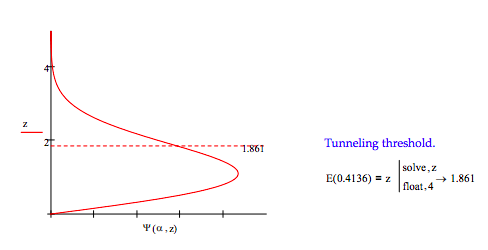10.10: Variation Method for a Particle in a Gravitational Field
- Page ID
- 136122
The particle of unit mass in a gravitational field for which g = 1 has the energy operator shown below.
\( - \frac{1}{2} \frac{d^2}{dz^2} \blacksquare + z \blacksquare\)
\( \int_{0}^{ \infty} \blacksquare dz\)
The following trial wave function for this problem is:
\( \Phi ( \alpha, z) := 2 ( \frac{2 \alpha}{ \pi ^{ \frac{1}{3}}})^{ \frac{3}{4}} z~exp ( - \alpha z^{2})\)
Determine whether or not the wave function is normalized.
\( \int_{0}^{ \infty} \Psi ( \alpha , z)^{2} dz |_{simplify}^{assume,~ \alpha > 0} \rightarrow 1\)
Evaluate the variational energy integral.
\( E ( \alpha ) := \int_{0}^{ \infty} \Psi ( \alpha , z) - \frac{1}{2} \frac{d^2}{dz^2} \Phi ( \alpha , z) dz ... |_{simplify}^{assume,~ \alpha >0} \rightarrow \frac{1}{2 \pi ^{ \frac{1}{2}}} \frac{3 \pi ^{ \frac{1}{2}} \alpha ^{2} + 2 (2)^{ \frac{1}{2}} \alpha ^{ \frac{1}{2}}}{ \alpha} + \int_{0}^{ \infty} z \Psi ( \alpha , z)^{2} dz\)
Minimize the energy with respect to the variational parameter \( \alpha\) and report its optimum value and the ground‐state energy.
\( \alpha := 1\) \( \alpha := Minimize(E, \alpha )\) \( \alpha = 0.4136\) \( E( \alpha ) = 1.8611\) \( E_{exact} := 1.8558\)
Plot the wave function with the distance of the particle from the surface on the vertical axis.

Find that distance below which there is a 90% probability of finding the particle.
\( \alpha := 1\)
Given \( \int_{0}^{a} \Psi ( \alpha , z)^{2} dz = .90\)
Find (a) = 1.9440
Find the most probable value of the position of the particle from the surface.
\( \frac{d}{dz} \Psi (0.4136, z) = 0 |_{float,~3}^{solve,~z} \rightarrow {\begin{pmatrix}
-1.10 \\
1.10
\end{pmatrix}}\)
Calculate the probability that the particle will be found below the most probable distance from the surface.
\( \int_{0}^{1.10} \Psi ( \alpha , z)^{2} dz = 0.4279\)
Calculate the probability that tunneling is occurring: \( \int_{1.861}^{ \infty} \Psi ( \alpha , z)^{2} dz = 0.1256\)
Kinetic energy: \( \int_{0}^{ \infty} \Psi ( \alpha , z) - \frac{1}{2} \frac{d^2}{dz^2} \Psi ( \alpha , z) dz = 0.6204\)
Potential energy: \( \int_{0}^{ \infty} z \Psi ( \alpha , z)^{2} dz = 1.2407\)
What is the apparent virial theorem for this system: \( E = 3T = \frac{3}{2} V\)

